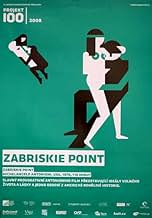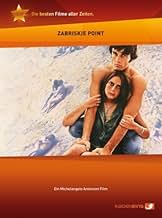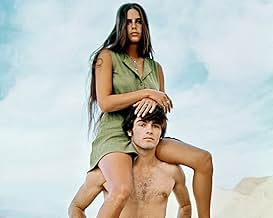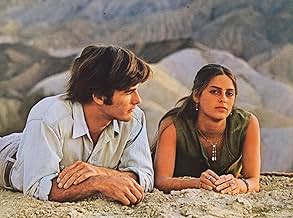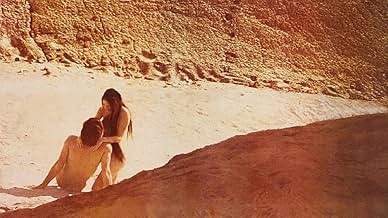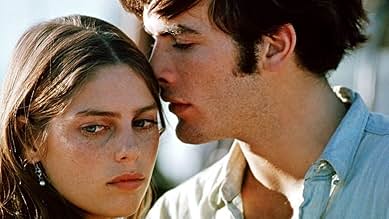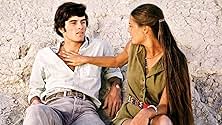IMDb रेटिंग
6.9/10
18 हज़ार
आपकी रेटिंग
अपनी भाषा में प्लॉट जोड़ेंAt a time of chronic civil unrest in late 1960s America, a young revolutionary suspected of murder steals a plane and meets a girl.At a time of chronic civil unrest in late 1960s America, a young revolutionary suspected of murder steals a plane and meets a girl.At a time of chronic civil unrest in late 1960s America, a young revolutionary suspected of murder steals a plane and meets a girl.
- पुरस्कार
- 1 जीत और कुल 1 नामांकन
Martin Abrahams
- Radical student
- (बिना क्रेडिट के)
Michael L. Davis
- Police lieutenant on loudspeaker
- (बिना क्रेडिट के)
Lee Duncan
- Highway patrolman
- (बिना क्रेडिट के)
George Dunn
- Airport mechanic
- (बिना क्रेडिट के)
Dennis Falt
- University student
- (बिना क्रेडिट के)
Harrison Ford
- Arrested student
- (बिना क्रेडिट के)
Jim Goldrup
- College student
- (बिना क्रेडिट के)
Norman Grabowski
- Man in Deli
- (बिना क्रेडिट के)
Bill Hickman
- Gun store owner
- (बिना क्रेडिट के)
- …
Kenner G. Kemp
- Departing Plane Passenger
- (बिना क्रेडिट के)
Peter Lake
- Documentary cameraman
- (बिना क्रेडिट के)
फ़ीचर्ड समीक्षाएं
About two hundred members of a Cleveland, Ohio USA film society, named Cinematheque, gathered on August 19, 2000 to view a pristine Cinemascope print of Michelangelo Antonioni's 1970 film, "Zabriskie Point." Cinematheque Director John Ewing, who does a superlative job of obtaining the finest prints for his series, shared with the audience beforehand that this print was specially flown over from Italy for this one showing only.
The audience was held spellbound as the film unfolded its artisty on the huge panoramic screen. Watching this superb print, shown the way Antonioni intended, made one aware that this is indeed a modern art work. It was all the more fitting that the series is housed in the Cleveland Insititue of Art in University Circle.
Antonioni's compositions are created for the Cinemascope landscape. His beautiful balancing of images, striking use of colors, sweeping choreographic movements, all are the work of a genuine artist, using the screen as his canvas.
At last the audience could understand "Zabriskie Point." As its narrative unfolded, it became obvious that this work is not about story per se, but rather an artist's impressionistic rendering of fleeting images of his subject. The setting of some of the more turbulent activities of the sixties provides only a dramatic motor for the artist's sweeping collage.
Antonioni is not bound by conventional narrative standards, and can pause at any point to creatively embroider an event with grandiose embellishments. The audience willingly went with the flow of his remarkable imagination, as his huge images on the massive canvas held one in rapt attention. While the audience may have been only tangentially involved in character relationships, it realized the theme here is human aleination, the director's recurring theme.
It was also realized that no print any smaller or of lesser quality than this original one in Cinemascope can do justice to this particular rendering. The audience was therefore all the more appreciative of viewing "Zabriskie Point" in its original, breathtaking format, and broke into thunderous applause at the end.
The audience was held spellbound as the film unfolded its artisty on the huge panoramic screen. Watching this superb print, shown the way Antonioni intended, made one aware that this is indeed a modern art work. It was all the more fitting that the series is housed in the Cleveland Insititue of Art in University Circle.
Antonioni's compositions are created for the Cinemascope landscape. His beautiful balancing of images, striking use of colors, sweeping choreographic movements, all are the work of a genuine artist, using the screen as his canvas.
At last the audience could understand "Zabriskie Point." As its narrative unfolded, it became obvious that this work is not about story per se, but rather an artist's impressionistic rendering of fleeting images of his subject. The setting of some of the more turbulent activities of the sixties provides only a dramatic motor for the artist's sweeping collage.
Antonioni is not bound by conventional narrative standards, and can pause at any point to creatively embroider an event with grandiose embellishments. The audience willingly went with the flow of his remarkable imagination, as his huge images on the massive canvas held one in rapt attention. While the audience may have been only tangentially involved in character relationships, it realized the theme here is human aleination, the director's recurring theme.
It was also realized that no print any smaller or of lesser quality than this original one in Cinemascope can do justice to this particular rendering. The audience was therefore all the more appreciative of viewing "Zabriskie Point" in its original, breathtaking format, and broke into thunderous applause at the end.
These are the late 60's and the early 70's as I have always imagined. As usual Antonioni uses all the registers of communications: the sounds, the colours, the movements of the actors. You could say that the plot is not well balanced, that the dialogues are often silly and meaningless, and maybe you are right. But Antonioni is a master in evoking feelings, simple, rough feelings, using all the tools a filmmaker has.
The movie has some jewels, and among them the most shining are the 10 final minutes. The oneiric explosion sequence, with the music that comes and goes, with the time expanded and slowed down, with the kitsch colours of meaningless objects moving upward in the blue sky. In the movie history this is one of the best images of the explosive and destructive power of the ingenuity of that generation, that wanted to live changing the existing rules. Playing with colour, time, sounds and music Antonioni has given once more a proof of his unforgettable art: he is at the same time a painter, a music composer, a dancer, a poet.
The movie has some jewels, and among them the most shining are the 10 final minutes. The oneiric explosion sequence, with the music that comes and goes, with the time expanded and slowed down, with the kitsch colours of meaningless objects moving upward in the blue sky. In the movie history this is one of the best images of the explosive and destructive power of the ingenuity of that generation, that wanted to live changing the existing rules. Playing with colour, time, sounds and music Antonioni has given once more a proof of his unforgettable art: he is at the same time a painter, a music composer, a dancer, a poet.
This is the film in Antonioni's middle period that most critics dismiss quickly, as a 'flawed' look at 60s American youth culture/politics. For what it's worth, I found it more touching and memorable than his more acclaimed films like L'AVVENTURA, perhaps because he shows more emotion & empathy here than anywhere else. The story is simple, but it is used as a frame for Antonioni's brilliant observations of, and critique on American consumerist culture, student life, the counter-culture, and the whole anti-establishment, anti-war backlash that was so prominent then.
Even from a purely technical point of view, it is a remarkably crafted film; from the opening credits sequence to the bizarre desert 'love-in', to the use of billboards, and right down to that jaw-dropping, cathartic finale that used 17 camera set-ups (in it's own way, as powerful as the climax of The Wild Bunch). Also, Antonioni chose one hell of a leading lady with Daria Halperin, one of the most beautiful ever to grace the screen. There isn't much 'acting' involved, as this feels more like a docu-drama, and so the use of non- professionals as the lead couple works quite effectively within that context. And the soundtrack is not only filled with marvelous music, its use is impressive as well (I can't forget the start of the film, mostly due to the selection of music - by Pink Floyd - that grooms the visuals so well).
Contrary to popular opinion, this is quite an achievement in cinema, and one I would enthusiastically recommend to anyone with a taste or tolerance for the off- beat. Well worth seeking out, and one of those key films of the 60s that demands a DVD restoration/release.
Even from a purely technical point of view, it is a remarkably crafted film; from the opening credits sequence to the bizarre desert 'love-in', to the use of billboards, and right down to that jaw-dropping, cathartic finale that used 17 camera set-ups (in it's own way, as powerful as the climax of The Wild Bunch). Also, Antonioni chose one hell of a leading lady with Daria Halperin, one of the most beautiful ever to grace the screen. There isn't much 'acting' involved, as this feels more like a docu-drama, and so the use of non- professionals as the lead couple works quite effectively within that context. And the soundtrack is not only filled with marvelous music, its use is impressive as well (I can't forget the start of the film, mostly due to the selection of music - by Pink Floyd - that grooms the visuals so well).
Contrary to popular opinion, this is quite an achievement in cinema, and one I would enthusiastically recommend to anyone with a taste or tolerance for the off- beat. Well worth seeking out, and one of those key films of the 60s that demands a DVD restoration/release.
I must admit, it's been (around) 2 years since I last saw Zabriskie Point...
For some reason it's never totally left my conscience yet generally for all the wrong reasons. While the cinematography is certainly impressive throughout I found that the whole ordeal just dragged, and dragged...and dragged, literally to the point of tedium. In the first instance then, Zabriskie Point is clearly suffering from pace, or lack of. The 'desert' or 'love' scene being a prime example of this - it's not art; it's not even vaguely artistic - but mundane and self indulgent. The gorgeous and sweltering locales of the desert are what's worth noting here; not two young protagonists who appear to share little, if no, connection.
In that respect it would seem that most people's opinions of Zabriskie Point are either deeply 'for' it or very much 'against' it. Were the 60s really like this?! Zabriskie Point seems to linger on too many stereotypes and while films such as Easy Rider managed to successful capture the ambience of counter-culture 1960s America Zabriskie Point falls just a bit short. Antonioni certainly knows how to lay-on some thick anti-establishment slurs but it's just so blatantly obvious and very hard to believe. On the plus side, the documentary-esque footage at the start of the film does help to give off a very 'real' vibe and is duly convincing. The acting, or lack of, is apt to an extent but hardly noteworthy. This is the frustrating element - it just seems to try so hard and has now gained a small reputation of being somewhat of a 'cult classic' but it's not justified. For those who try to read what they want to read into a film for the sake of art or intellect; those who subsequently look for hidden meanings that aren't there - maybe try this. If I wanted to do that I'd happily watch El Topo - not that I would ever compare the two.
Oh, did I mention Pink Floyd contributed to the soundtrack perhaps one of the only serious redeeming qualities here. Thanks Dave and Roger.
6/10
For some reason it's never totally left my conscience yet generally for all the wrong reasons. While the cinematography is certainly impressive throughout I found that the whole ordeal just dragged, and dragged...and dragged, literally to the point of tedium. In the first instance then, Zabriskie Point is clearly suffering from pace, or lack of. The 'desert' or 'love' scene being a prime example of this - it's not art; it's not even vaguely artistic - but mundane and self indulgent. The gorgeous and sweltering locales of the desert are what's worth noting here; not two young protagonists who appear to share little, if no, connection.
In that respect it would seem that most people's opinions of Zabriskie Point are either deeply 'for' it or very much 'against' it. Were the 60s really like this?! Zabriskie Point seems to linger on too many stereotypes and while films such as Easy Rider managed to successful capture the ambience of counter-culture 1960s America Zabriskie Point falls just a bit short. Antonioni certainly knows how to lay-on some thick anti-establishment slurs but it's just so blatantly obvious and very hard to believe. On the plus side, the documentary-esque footage at the start of the film does help to give off a very 'real' vibe and is duly convincing. The acting, or lack of, is apt to an extent but hardly noteworthy. This is the frustrating element - it just seems to try so hard and has now gained a small reputation of being somewhat of a 'cult classic' but it's not justified. For those who try to read what they want to read into a film for the sake of art or intellect; those who subsequently look for hidden meanings that aren't there - maybe try this. If I wanted to do that I'd happily watch El Topo - not that I would ever compare the two.
Oh, did I mention Pink Floyd contributed to the soundtrack perhaps one of the only serious redeeming qualities here. Thanks Dave and Roger.
6/10
The movie presents a view of the United States that only a foreigner could have. Sadly, foreigners can't relate to it and persons from the United States cannot believe it. The movie is, therefore, caught in limbo without an audience. Reviews of the film tend to reflect this.
I have lived away from the US for 30 years and can now pretend to be able to understand what Antonioni was wanting to achieve. My view is that he has excelled. The film is a stunning indictment of the United States and, tragically, I see no remediation in the 29 years since it was first released.
I have lived away from the US for 30 years and can now pretend to be able to understand what Antonioni was wanting to achieve. My view is that he has excelled. The film is a stunning indictment of the United States and, tragically, I see no remediation in the 29 years since it was first released.
क्या आपको पता है
- ट्रिवियाAntonioni met with Jim Morrison during early production to ask for a musical contribution to the soundtrack. Morrison and the Doors provided "L'America" which Antonioni then rejected.
- गूफ़Zabriskie Point, in Death Valley National Park (California, USA) is not actually the lowest-elevation point in the United States. That would be Badwater Basin, at a depth of 282 feet below sea level, which is also located in Death Valley National Park about 20 miles away.
- भाव
[booking a protester]
Cop: Occupation?
William S. Polit, protester: Associate professor of history.
Cop: That's too long, Bill. I'll just put down clerk.
- इसके अलावा अन्य वर्जनIn the original version, the song that's playing when Daria drives away at the very end and over the closing "End" title card is a Roy Orbison song, but in the 1984 MGM/UA Home Video version it's a continuation of the Pink Floyd song. The 1991 MGM/UA Home Video version restores the Orbison song.
- कनेक्शनEdited into Histoire(s) du cinéma: La monnaie de l'absolu (1999)
टॉप पसंद
रेटिंग देने के लिए साइन-इन करें और वैयक्तिकृत सुझावों के लिए वॉचलिस्ट करें
- How long is Zabriskie Point?Alexa द्वारा संचालित
विवरण
बॉक्स ऑफ़िस
- बजट
- $70,00,000(अनुमानित)
- दुनिया भर में सकल
- $84,879
- चलने की अवधि1 घंटा 53 मिनट
- ध्वनि मिश्रण
- पक्ष अनुपात
- 2.35 : 1
इस पेज में योगदान दें
किसी बदलाव का सुझाव दें या अनुपलब्ध कॉन्टेंट जोड़ें



